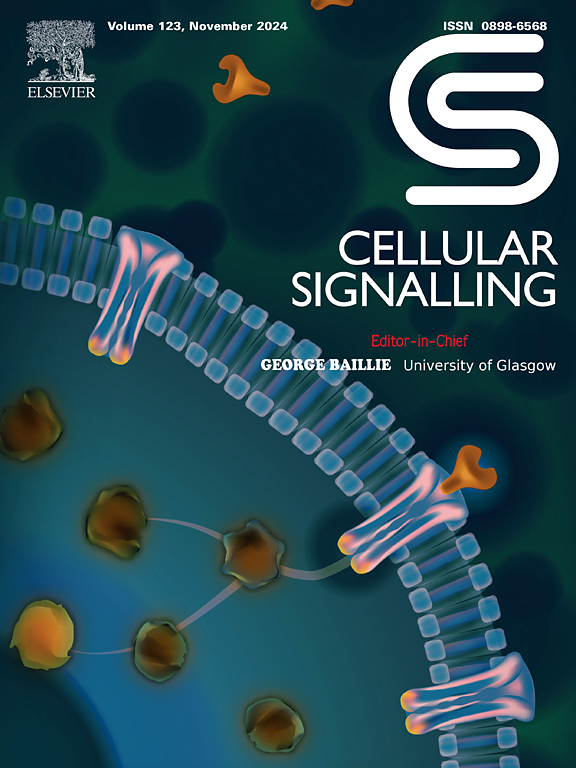miRNA-548d-3p通过JAK2/STAT3信号干扰ddx5介导的焦亡,从而抑制非小细胞肺癌的生长。
IF 3.7
2区 生物学
Q2 CELL BIOLOGY
引用次数: 0
摘要
背景:microRNAs (miRNAs)在肿瘤发展中的功能已被广泛研究。焦亡是一种程序性死亡,可以有效地阻碍肿瘤的发展。然而,mirna在NSCLC焦亡中的功能仍有很大的差距。方法:应用生物信息学方法分析NSCLC中与热死相关的差异表达mirna及其潜在靶点。在体内和体外验证miR-548d-3p对细胞增殖、焦亡和肿瘤生长的影响。在细胞和异种移植肿瘤中检测了焦热相关因子的表达。此外,通过Co-IP和双荧光素酶报告基因检测来评估分子相互作用。结果:我们发现,在公共数据集和48例非小细胞肺癌患者的独立队列中,miR-548d-3p在非小细胞肺癌中表达不良。miR-548d-3p低表达与NSCLC患者病理性T分期及不良预后呈正相关。转染miR-548d-3p模拟物可显著降低NSCLC细胞的细胞活力,部分原因是热噬细胞比例增加。这些变化伴随着NLRP3、ASC、cleaved Caspase-1和GSDMD-N蛋白丰度的升高以及IL-1β和IL-18的释放。结合生物信息学、表达和实验分析,我们预测并验证了DDX5是miR-548d-3p的直接靶点。此外,我们在体外和体内证明了miR-548d-3p/DDX5轴通过磷酸化的JAK2/ stat3介导的NLRP3/Caspase-1/GSDMD途径调节焦亡。结论:我们的研究发现miR-548d-3p/DDX5通过促进JAK2/STAT3/NLRP3/Caspase-1/GSDMD通路促进NSCLC的焦亡,提示miR-548d-3p在NSCLC治疗中具有良好的作用。本文章由计算机程序翻译,如有差异,请以英文原文为准。
miRNA-548d-3p represses non-small cell lung cancer growth by perturbing DDX5-mediated pyroptosis through JAK2/STAT3 signaling
Background
The function of microRNAs (miRNAs) in tumor development has been extensively characterized. Pyroptosis is a kind of programmed death, which can effectively hinder cancer development. However, there is still a large gap in the function of miRNAs in NSCLC pyroptosis.
Methods
The pyroptosis-related differentially expressed miRNAs and their promising targets in NSCLC were analyzed using bioinformatic analyses. The effects of miR-548d-3p on cell proliferation, pyroptosis and tumor growth were verified in vivo and in vitro. The expression of pyroptosis-related factors was examined in cells and xenografted tumors. Additionally, the molecular interaction was assessed by using Co-IP and dual-luciferase reporter gene assays.
Results
We found that miR-548d-3p was poorly expressed in NSCLC in public datasets and an independent cohort of 48 NSCLC patients. Low miR-548d-3p expression was positively associated with pathologic T stage and poor prognosis of NSCLC patients. Transfection of miR-548d-3p mimics significantly decreased the cell viability of NSCLC cells, partly attributing to the increase in the proportion of pyroptotic cells. These changes were accompanied by a rise in the protein abundance of NLRP3, ASC, cleaved Caspase-1 and GSDMD-N and release of IL-1β and IL-18. Integrating bioinformatic, expressional and experimental analyses, we predicted and validated DDX5 as the direct target of miR-548d-3p. Furthermore, we demonstrated that miR-548d-3p/DDX5 axis regulated pyroptosis via the Phosphorylated JAK2/STAT3-mediated NLRP3/Caspase-1/GSDMD pathway in vitro and in vivo.
Conclusion
Our study revealed that miR-548d-3p/DDX5 promoted pyroptosis in NSCLC by promoting the JAK2/STAT3/NLRP3/Caspase-1/GSDMD pathway, indicating the promising effect of miR-548d-3p in NSCLC treatment.
求助全文
通过发布文献求助,成功后即可免费获取论文全文。
去求助
来源期刊

Cellular signalling
生物-细胞生物学
CiteScore
8.40
自引率
0.00%
发文量
250
审稿时长
27 days
期刊介绍:
Cellular Signalling publishes original research describing fundamental and clinical findings on the mechanisms, actions and structural components of cellular signalling systems in vitro and in vivo.
Cellular Signalling aims at full length research papers defining signalling systems ranging from microorganisms to cells, tissues and higher organisms.
 求助内容:
求助内容: 应助结果提醒方式:
应助结果提醒方式:


